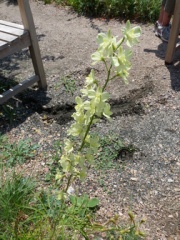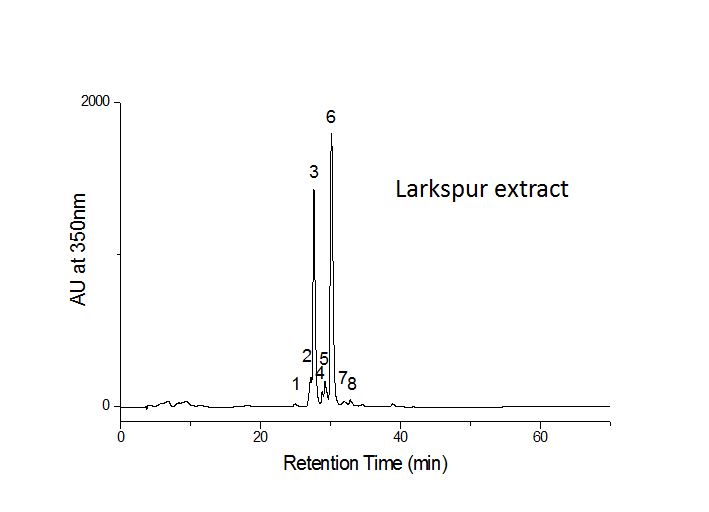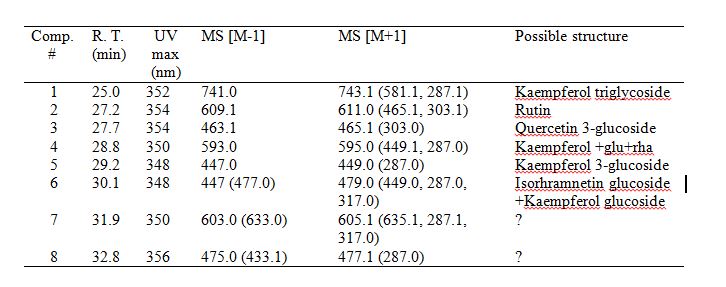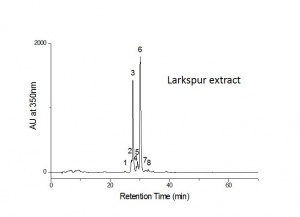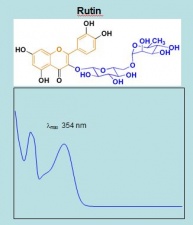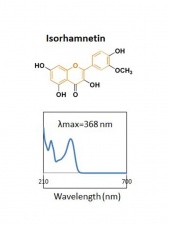Larkspur (Delphinium semibarbatum) LC
Description
The yellow larkspur, (Delphinium semibarbatum) is a perennial plant that can grow to 30-80 cm high with a simple or few-branched erect stem. It grows on mountain meadows and grassy plains to a height of 2,000 m in central Asia, and from Iran and Afghanistan to northern India.
When the blooming season comes, the flowering stems are used to dye yellow.
Yellow larkspur is a source of CI Natural Yellow 10.
Historical importance
Yellow larkspur was one of the main sources of yellow dye in central Asia before the adoption of synthetic dyes in this region. It was used in the silk and silk-and-cotton ikats of the Uzbeks, Tajiks, Turkmens and Jews [1].
Mark Whiting reported that larkspur was the main yellow dye used by the nomadic people of Persia, the Caucasus and Turkestan in the 19th century [2]. Nevin enez and Harald Bohmer identified larkspur as the source of the yellow dye in a prayer rug preserved in the Topkapi Museum [3].
Examples:
Summary of results
Falovnols present as 3-O-glycosides: quercetin, kaempferol and isorhamnetin are detected as main colorants.
Analytical instrumentation and procedures
HPLC-DAD-MS analysis was performed with an Agilent 1100 liquid chromatography system consisting of an automatic injector, a gradient pump, a HP series 1100 DAD, and an Agilent series 1100 VL on-line atmospheric pressure ionization electrospray ionization mass spectrometer. Separations were done on a Vydac 214TP52 analytical column (2.1 mm diameterX250 mm; 5-ím particle size). The column was eluted at a flow rate of 0.2 mL/min with a tertiary gradient of water (A),acetonitrile (B), and 1% (v/v) aqueous formic acid (C) with the following elution program: 0 min, 90% A, 5% B, 5% C; 0-55 min, a linear gradient to 35% A, 60% B, 5% C; 55-60 min, a linear gradient elution to 15% A, 80% B, 5% C; 60-62 min, isocratic elution at 15% A, 80% B, 5% C; 62-70 min gradient elution to 90% A, 5% B, 5% C; and reequilibration with the latter solvent for 15 min. The mass spectrometer was run both in the negative and positive ion mode [Method 1].
Chromatograms
HPLC-DAD
For this analysis, yellow larkspur (Delphinium semibarbatum) flowers from Turkey were extracted with 1 mL methanol:H2O (v:v=1:1). Then the upper 30 μl of solution was removed for HPLC-DAD-MS analysis (20 μl was injected).
Results
Identified compounds
| Compound | RT (min.) | MW | UV/vis | Other | |
|---|---|---|---|---|---|
| quercetin 3-O-glycoside | 27.7 | 464 | 278,352 | Comments here | |
| kaempferol 3-O-glycoside | 30.1 | 448 | 280,395,370 | ||
| isorhamnetin 3-O-glycoside | 30.1 | 478 | 280,395,368 |
References
[1] Cardon, Dominique. "Natural dyes, sources, Traditions, Technology and Science" 169 (2007).
[2] Cardon, Dominique. "Natural dyes, sources, Traditions, Technology and Science" 168 (2007).
[3] Zhang, X., and Laursen, R. A., Development of Mild Extraction Methods for the Analysis of Natural Dyes in Textiles of Historical Interest Using LC-Diode Array Detector-MS. Analytical Chemistry 77, 2022-2025 (2005).
